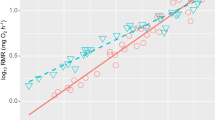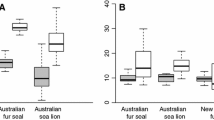Abstract
An inverse relationship exists between erythrocyte size and the aerobic swimming ability of teleosts. A functional basis for this relationship is found in larger surface area to volume ratios and shorter diffusion distances allowing more rapid oxygen transfer as erythrocyte volume decreases. However, this apparently simple functional relationship is confounded by a more general direct relationship between cell size and nuclear volume. Nuclear DNA content, which is directly proportional to nuclear volume, is known to vary at least 11 fold among teleost species. Therefore a question arises as to the relative contributions of nuclear volume and the demands of the blood oxygen delivery system in determining erythrocyte volume.
These relationships were investigated by regressing erythrocyte volume against nuclear volume and whole blood haemoglobin concentration (as an index of aerobic scope) for 52 species of teleost fish from 25 families. This analysis shows that erythrocyte volume is more highly correlated with oxygen delivery than with nuclear volume. However, much of the variation in erythrocyte volume is unexplained.
Similar content being viewed by others
References
Alexander, N., Laurs, R.M., McIntosh, A. and Russell, S.W. 1980. Haematological characteristics of albacore, Thunnas alalunga (Bonnaterre), and skipjack,Katsuwonus pelamis (Linnaeus). J. Fish Biol. 16: 383–395.
Cavalier-Smith, T. 1985. Cell volume and the evolution of eukaryote genome size. In The Evolution of Genome Size. pp. 105–184. Edited by T. Cavalier-Smith. John Wiley and Sons, New York.
Dacie, J.V. and Lewis, S.M. 1975. Practical Haematology, 5th Edition. Churchill Livingstone, Edinburgh.
Dawson, A.B. 1933. The relative numbers of immature erythrocytes in the circulatory blood of several species of marine fishes. Biol. Bull. 64: 33–43.
Gommon, M.F., Glover, J.C.M. and Kuiter, R.H. 1994. The Fishes of Australia's South Coast. State Printers, Adelaide.
Graham, M.S., Haedrich, R.L. and Fletcher, G.L. 1985. Hematology of three deep-sea fishes: A reflection of low metabolic rates. Comp. Biochem. Physiol. 80A: 79–84.
Grant, E.M. 1993. Grant's Guide to Fishes. E.M. Grant Pty. Ltd. Scarborough, Queensland.
Hinegardner, R. and Rosen, D.E. 1972. Cellular DNA content and the evolution of teleostean fishes. Amer. Nat. 106: 621–644.
Holland, R.A.B. and Forster, R.E. 1966. The effect of size of red cells on the kinetics of their oxygen uptake. J. Gen. Physiol. 49: 727–742.
Horner, H.A. and Macgregor, H.C. 1983. C value and cell volume: Their significance in the evolution and development of amphibians. J. Cell. Sci. 63: 135–146.
Jones, D.A. 1979. The importance of surface area/volume ratio to the uptake of oxygen by red cells. J. Gen. Physiol. 74: 643–646.
Klawe, W.L., Barrett, I. and Klawe, B.M.H. 1963. Haemoglobin content of the blood of six species of scombroid fishes. Nature 198: 96.
Larsson, A., Johansson-Sjobeck, M-L. and Fange, R. 1976. Comparative study of some haematological and biochemical blood parameters in fishes from the Skagerrak. J. Fish. Biol. 9: 425–440.
Monnickendam, M.A. and Balls, M. 1973. The relationship between cell sizes, respiration rates and survival of amphibian tissues in long-term organ cultures. Comp. Biochem. Physiol. 44A: 871–880.
Nurse, P.1985. The genetic control of cell volume. In The Evolution of Genome Size. pp 185–196. Edited by T. Cavalier-Smith. John Wiley and Sons, New York.
Olmo, E. and Morescalchi, A. 1975. Evolution of the genome and cell sizes in salamanders. Experientia 31: 804–806.
Olmo, E. and Morescalchi, A. 1978. Genome and cell sizes in frogs: a comparison with salamanders. Experientia 34: 44–46.
Olmo, E., Capriglione, T. and Odierna, G. 1989. Genome size evolution in vertebrates: trends and constraints. Comp. Biochem. Physiol. 92B: 447–453.
Pierce, A.G.E. 1968. Histochemistry. Vol. 1. Churchill, London
Putnam, R.W. and Freel, R.W. 1978. Hematological parameters of five species of marine fishes. Comp. Biochem. Physiol. 61A: 585–588.
Randall, J.E., Allen, G.R. and Steen, R.C 1990. Fishes of the Great Barrier Reef and Coral Sea. University of Hawaii Press, Hawaii.
Sanson, G.D., Stolk, R. and Downes, B.J. 1995. A new method for characterizing surface roughness and available space in biological systems. Functional Ecol. 9: 127–135.
Smith, H.M. 1925. Cell size and metabolic activity in amphibia. Biol. Bull. 48: 347–378.
Szarski, H. 1970. Changes in the amounts of DNA in cell nuclei during vertebrate evolution. Nature, Lond. 226: 651–652.
Szarski, H. 1976. Cell size and nuclear DNA content in vertebrates. Int. Rev. Cytol. 44: 93–111.
Szarski, H. 1983. Cell size and the concept of wasteful and frugal evolutionary strategies. J. Theor. Biol. 105: 201–209.
Wells, R.M.G., and Baldwin, J. 1990. Oxygen transport potential in tropical reef fish with special reference to blood viscosity and haematocrit. J. Exp. Mar. Biol. Ecol. 41: 131–143.
Wilhelm Filho, D., Eble, G.J., Kassner, G., Caprario, F.X., Dafre, A.L. and Ohira, M. 1992. Comparative hematology in marine fish. Comp. Biochem. Physiol. 102A: 311–321.
Author information
Authors and Affiliations
Rights and permissions
About this article
Cite this article
Lay, P., Baldwin, J. What determines the size of teleost erythrocytes? Correlations with oxygen transport and nuclear volume. Fish Physiology and Biochemistry 20, 31–35 (1999). https://doi.org/10.1023/A:1007785202280
Issue Date:
DOI: https://doi.org/10.1023/A:1007785202280




